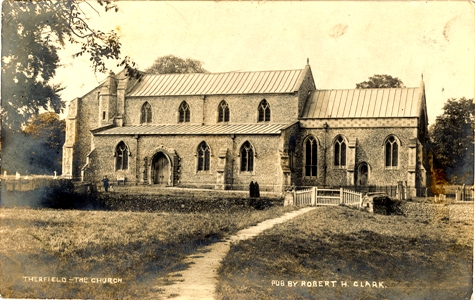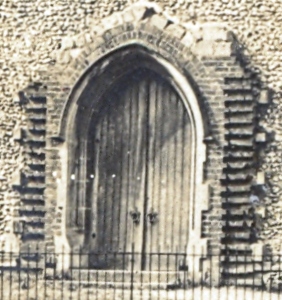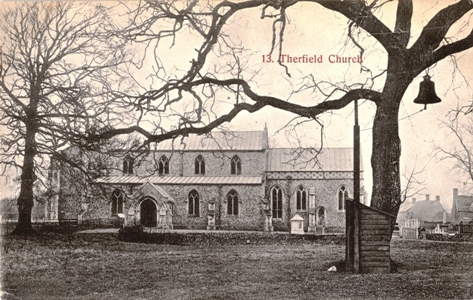|
|
This picture of the church comes from Cussans' History of Hertfordshire, published in 1873. Because the church was in danger of collapse (note the massive buttresses) it was demolished and a new church erected on the site starting in 1878. |
|
Francis Turner D.D. (1637 – 1700) was Bishop of Ely, one of the seven bishops who petitioned against the Declaration of Indulgence and one of the nine bishops who refused to take the oath of allegiance to William III. [From Wikipedia] He became Rector of Therfield in 1664 and was buried in the church
Text of memorial from Salmon's The History of Hertfordshire è |
 |
See TURNER, Therfield, 18th century for later Turner memorials
Building the New Church
 |
 |
|
|
Therfield - The Church postcard by
Robert H Clarke posted 1904 Another view with incomplete porch è |
|
|
 |
|
The church of St Mary the Virgin, erected on the site of the former church, at a cost of £4,600, exclusive of the chancel, rebuilt by the Rev. J. G. Hale M.A. rector 1870-1907, is an edifice of flint and rubble stone in the Decorated style from designs by Mr. G. E. Pritchett, architect of Bishop Stortford, and consists of chancel, clerestoried nave of four bays, aisles and a tower, erected in 1911 and containing 6 bells, dated respectively 1689, 1626, 1656, 1597, 1608 and 1707: the church affords 510 sittings. The register dates from the year 1538. The living is a rectory, net yearly value £538, including 66 acres of glebe and residence, in the gift of the Dean and Chapter of St. Paul's, and held since 1907 by the Rev. Frederick Roberts Blatch M.A. of Oriel College, Oxford. [Kelly's Directory for Hertfordshire, 1914] |
|
|
|
|
|
|
The rectory house is an interesting building. It has been added to from time to time, and the E. portion is ancient. This portion has a gable end, and there was once a similar wing, of which the foundations have been discovered, on the W. side. In this wing we find several panelled rooms and the aperture of a winding staircase. Rector John Mountford, Prebendary of St. Paul's, 1640-1650, is said to have rebuilt a great part of the rectory house. The register states that in 1769 Charles Weston rebuilt the greater part. Charles Moss, afterwards Bishop of Oxford, added the library in 1800. The well in the yard, which is now 276 ft. deep, was deepened by Bishop Sherlock, and again by Archdeacon Robinson. |
 |
A SERMON Preach'd before the QUEEN at St JAMES's on Munday JANUARY 31, 1703/4 being the Anniversary of the Martyrdom of King CHARLES the First
by THOMAS SHERLOCK,. M.A. Rector of Therfield, Hertfordshire
Published by Her Majesties Special Command
LONDON Printed by H. Hills, in Black-fryars, near the Waterside For the Benefit of the Poor. 1708
Cover of the Sermon being sold on ebay October 2012 |
|
|
WILLIAM SHERLOCK was born in Southwark about the year 1641, and on leaving Eton, where he received his education, was entered at Peter House, Cambridge, where, in 1665, he took his degree of M.A. In 1669 he was presented to the Rectory of St. George's, Botolph Lane, London, which he held for some years. In 1683 he was collated to a Prebend in St. Paul's, and appointed Master of the Temple during the following year. On the accession of William and Mary, he refused to take the oaths, and was therefore suspended from all his preferments: he was, however, reinstated shortly after, on his compliance with the ordinance. In 1691 he was made Dean of St. Paul's, and died Hampstead on the 19th June, 1707. He was buried in St. Paul's Cathedral. He was the author of several polemical and controversial works, chiefly directed against the Nonconformists. THOMAS SHERLOCK, eldest son of the last rector, was born in London in 1678, and, like his father, received his early education at Eton. About 1693 he was admitted to Catherine Hall, Cambridge, where, in 1701, he took the degree of M.A. In 1714 he took the degree of D.D., and was elected to the Mastership of his College. In 1716 he was made Dean of Winchester. In] 728 he was promoted to the Bishopric of Bangor; six years later he was translated to the see of Salisbury; and on the 12th October, 1748, he was translated to the see of London. He died on the 18th July, 1761, and was buried at Fulham. He published five volumes of sermons, and a number of political and controversial pamphlets. Cussans, History of Hertfordshire |
||
| October 2010 | Set up as separate page with new information | |
| October 2012 | Sermon | |
| July 2013 | Interior of church pc |